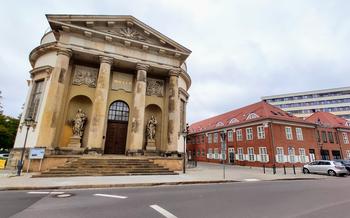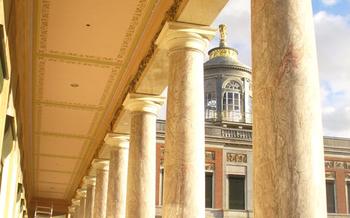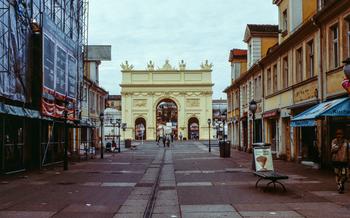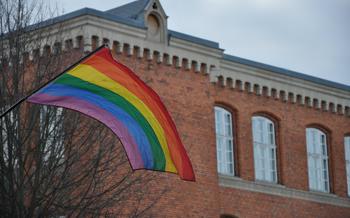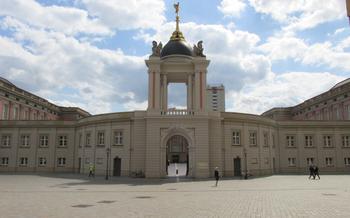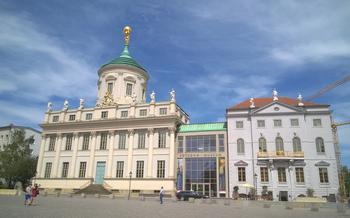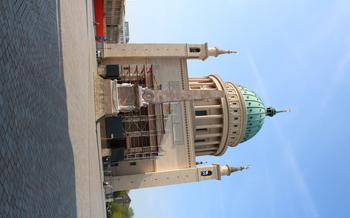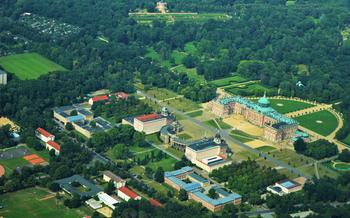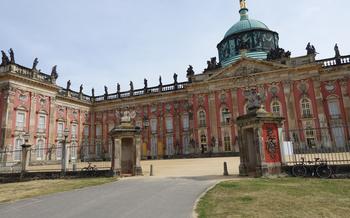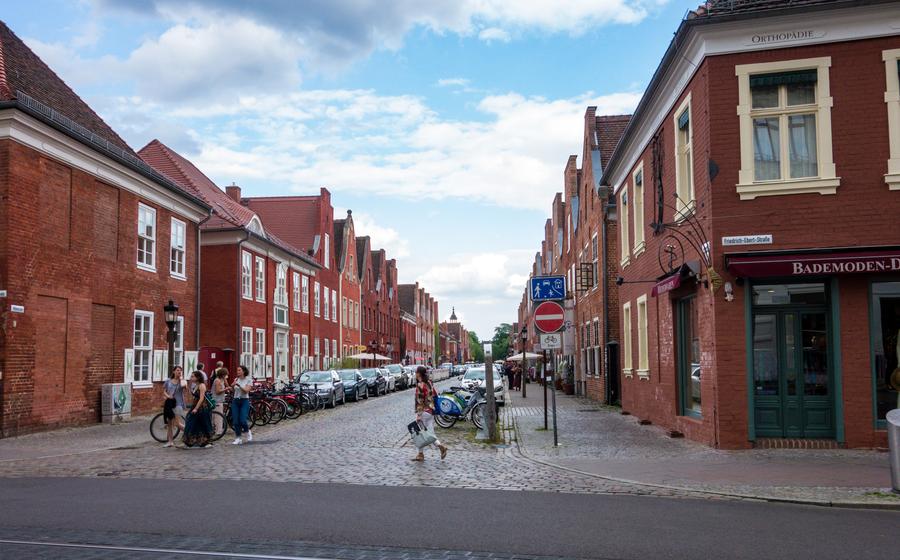
The Dutch Quarter in Potsdam
- Historical Background:
- Location and Accessibility
- Architectural Highlights
- Cultural Significance
- Must-See Attractions
- Unique Experiences in the Dutch Quarter
- Shopping and Dining
- Accommodation Options
- Local Customs and Etiquette
- Photography Opportunities
- Family-Friendly Activities
- Off-the-Beaten-Track Experiences
- Budget Tips
- Insider Tip:
Historical Background:
In the 17th century, Potsdam, a picturesque city nestled on the banks of the River Havel, witnessed a remarkable transformation under the reign of Frederick William I, the "Soldier King." Inspired by his admiration for Dutch craftsmanship and urban planning, Frederick William I invited skilled Dutch craftsmen and artisans to settle in Potsdam, resulting in the creation of the Dutch Quarter. This unique neighborhood, with its distinctive architectural style and cultural heritage, played a significant role in shaping the city's identity and contributing to its rich history. The Dutch Quarter stands as a testament to the vibrant exchange of ideas and skills between Prussia and the Netherlands during this era, leaving an enduring legacy that continues to captivate visitors to this day.
Location and Accessibility
The Dutch Quarter is nestled in the heart of Potsdam, a city located just outside of Berlin, Germany. It occupies an area bounded by Brandenburger Straße to the north, Charlottenstraße to the south, Friedrich-Ebert-Straße to the west, and Am Kanal to the east. The neighborhood is within easy walking distance of Potsdam's main attractions, including the Sanssouci Palace, the Orangery Palace, and the New Palace. Visitors can reach the Dutch Quarter by taking the S-Bahn (suburban train) to the Potsdam Hauptbahnhof station and then transferring to bus line 695 or 69Alternatively, they can take a taxi or rent a bike to explore the area at their own pace.
Architectural Highlights
The Dutch Quarter is a treasure trove of architectural wonders, reflecting the unique blend of Dutch and Prussian influences. The neighborhood is characterized by its charming gabled roofs, colorful facades, and intricate brickwork. One of the most notable buildings in the quarter is the Dutch Church, built in the 18th century and featuring a striking bell tower. The church is a testament to the Dutch community's religious devotion and cultural heritage.
Strolling through the quarter, visitors will encounter rows of beautifully preserved townhouses, each with its own unique character. The houses are adorned with decorative elements such as pilasters, cornices, and pediments, showcasing the craftsmanship and attention to detail of Dutch builders. The vibrant colors of the facades, often painted in shades of yellow, blue, and green, add to the neighborhood's cheerful and inviting atmosphere.
The Dutch Quarter has undergone extensive preservation efforts in recent years, ensuring that its architectural integrity is maintained for future generations. Restoration projects have been carried out to restore the buildings to their original glory, using traditional techniques and materials. These efforts have successfully preserved the unique charm and character of the neighborhood, making it a living testament to the rich history of Potsdam.
Cultural Significance
The Dutch Quarter is a testament to the profound cultural influence that the Netherlands had on Potsdam during the Prussian era. Dutch craftsmen and artisans brought their skills and expertise to the city, leaving an indelible mark on its architecture, craftsmanship, and trade. The neighborhood showcases this cultural exchange and integration, blending Dutch traditions with Prussian heritage.
The Dutch Quarter is a living example of cultural fusion, where Dutch architectural styles and craftsmanship techniques can be seen in many of the buildings, creating a unique and harmonious blend of cultures. This harmonious coexistence is a testament to the open and welcoming nature of both the Dutch and Prussian communities, who embraced each other's cultures and created a vibrant and diverse neighborhood.
The Dutch influence is also evident in the area's cultural events and festivals. The annual Dutch Festival, for example, celebrates the neighborhood's Dutch heritage with traditional music, food, and dance. These events provide visitors with an opportunity to experience the vibrant Dutch culture and its enduring legacy in Potsdam.
Must-See Attractions
The Dutch Quarter is home to several must-see attractions that offer a glimpse into its rich history and cultural significance. Here are some of the top places to visit:
-
The Dutch Church (Holländische Kirche): This 17th-century church is an iconic landmark of the Dutch Quarter, known for its impressive architecture and intricate interior. The church features a stunning pulpit and a beautiful organ, and it regularly hosts concerts and events.
-
The Potsdam Museum: This museum is dedicated to the history and culture of Potsdam, with a particular focus on the Dutch Quarter. Visitors can learn about the neighborhood's origins, its role in the Prussian era, and the influence of Dutch culture on the city.
-
The Old Town Hall (Altes Rathaus): This historic building served as the town hall of Potsdam during the 18th and 19th centuries. Today, it houses the City Museum, which showcases exhibits on local history, art, and culture.
-
The Brandenburg Gate (Brandenburger Tor): This iconic gate is located at the western entrance to the Dutch Quarter and is one of Potsdam's most famous landmarks. Inspired by the Brandenburg Gate in Berlin, it was built in 1770 and offers a stunning view of the surrounding area.
-
The Friendship Island (Freundschaftsinsel): This picturesque island is located in the Havel River, just a short walk from the Dutch Quarter. It features beautiful gardens, a small palace, and a variety of sculptures. The island is a popular spot for relaxation and recreation, and it offers stunning views of the city.
Unique Experiences in the Dutch Quarter
Beyond exploring the architectural wonders and historical significance of the Dutch Quarter, visitors can immerse themselves in unique and immersive experiences that capture the essence of Dutch culture and heritage. Participate in cultural workshops to learn traditional Dutch crafts like pottery, woodworking, or cheesemaking. These hands-on experiences offer a deeper understanding of the skills and artistry that shaped the neighborhood's character. Guided tours led by local experts provide fascinating insights into the history, architecture, and cultural influences that shaped the Dutch Quarter. These tours often include hidden gems and anecdotes that bring the neighborhood's past to life.
Indulge in the flavors of Dutch cuisine at traditional restaurants and cafes that serve authentic dishes prepared with fresh, local ingredients. Sample the famous Dutch pancakes, known as pannenkoeken, or try traditional stews and hearty soups that reflect the culinary traditions of the Netherlands. Don't miss the opportunity to savor freshly baked pastries and sweet treats at local bakeries, where the aroma of warm bread and pastries fills the air. Throughout the year, the Dutch Quarter hosts special events and seasonal activities that celebrate its unique heritage. Attend traditional Dutch festivals, witness cultural performances, or participate in themed markets that showcase local crafts, food, and music. These events offer a vibrant and lively atmosphere, allowing visitors to experience the neighborhood's cultural traditions firsthand.
Shopping and Dining
The Dutch Quarter is a shopper's paradise, with a variety of boutiques and shops offering unique souvenirs, Dutch-inspired crafts, and locally made products. Visitors can find everything from traditional Delftware to handmade wooden shoes, as well as contemporary home goods and fashion accessories. For a truly unique shopping experience, head to the Kunsthandwerkermarkt (Arts and Crafts Market), held every Saturday in the quarter's central square.
When it comes to dining, the Dutch Quarter offers a delectable array of culinary experiences. From traditional Dutch restaurants serving hearty meals like stamppot (mashed potatoes with vegetables) and poffertjes (mini pancakes) to cozy cafes offering Dutch-inspired pastries and coffee, there's something to satisfy every palate. Be sure to try local specialties like smoked eel, herring, and the famous Dutch cheese, Gouda. For a memorable dining experience, reserve a table at one of the many riverside restaurants offering stunning views of the Dutch Quarter and the surrounding canals.
Accommodation Options
When seeking accommodation in or near the Dutch Quarter, visitors will find a range of options to suit various preferences and budgets. For a truly immersive experience, consider staying within the neighborhood itself. Hotel Am Dutch Quarter offers comfortable rooms in a historic building, while Pension Potsdam provides a cozy and affordable stay in a charming guesthouse.
For those seeking a more luxurious experience, the Grand Hotel Potsdam is a five-star hotel located just a short walk from the Dutch Quarter. It offers elegant rooms, a spa, and a rooftop terrace with stunning views of the city.
For budget-conscious travelers, Jugendherberge Potsdam is a popular option. It provides basic but comfortable rooms at an affordable price. Alternatively, Airbnb offers a range of apartments and rooms for rent, allowing travelers to experience the neighborhood like a local.
No matter the choice of accommodation, visitors to the Dutch Quarter will find themselves in the heart of Potsdam's history and culture, with easy access to all that the neighborhood and the city have to offer.
Local Customs and Etiquette
When exploring the Dutch Quarter, it's important to be mindful of local customs and etiquette to ensure respectful interactions with the community. Potsdam's culture is generally friendly and welcoming, but understanding certain social norms can enhance your experience. Here are a few tips to consider:
-
Greetings: When meeting someone, it's customary to shake hands firmly and make eye contact. A simple "Guten Tag" (good day) or "Hallo" (hello) is an appropriate greeting.
-
Language: German is the official language of Potsdam, and most locals are proficient in English. However, making an effort to learn a few basic German phrases, such as "Bitte" (please) and "Danke" (thank you), can be appreciated.
-
Tipping: Tipping is customary in Germany, and a 10-15% tip is generally expected in restaurants and cafes. You can leave the tip in cash or add it to your bill.
-
Personal Space: Germans tend to value personal space, so avoid standing too close to someone or invading their personal bubble, especially in public places.
-
Recycling: Germany has a strong emphasis on recycling, so be sure to separate your waste into the designated recycling bins. This helps to reduce environmental impact and is appreciated by the community.
Photography Opportunities
The Dutch Quarter is a photographer's paradise, with picturesque canals, colorful facades, and charming streetscapes that beg to be captured. Don't forget your camera or smartphone to immortalize your visit to this historic neighborhood.
-
Perfect Angles: To capture the grandeur of the Dutch architecture, position yourself at an angle to accentuate the height of the gabled roofs and the intricate details of the facades.
-
Golden Hour Magic: The best time to photograph the Dutch Quarter is during the golden hour, just before sunset, when the warm light casts a magical glow on the buildings and canals.
-
Reflections and Symmetry: Take advantage of the canals to create stunning reflections of the Dutch Quarter's colorful facades. Look for symmetrical compositions that mirror the architecture and create a sense of balance in your shots.
-
Street Scenes: Capture the vibrant street life of the Dutch Quarter by photographing locals going about their daily lives, children playing in the streets, or bicycles parked along the canals.
-
Unique Perspectives: Don't be afraid to experiment with different angles and vantage points. Climb to a higher vantage point for a bird's-eye view of the neighborhood or get up close to capture the intricate details of the architecture.
Family-Friendly Activities
The Dutch Quarter offers a wealth of family-friendly attractions that cater to children of all ages. Families with young children should not miss the Kindermuseum Labyrinth, an interactive museum designed to spark curiosity and imagination. Kids can explore hands-on exhibits, solve puzzles, and engage in creative activities that promote learning and development.
For a fun-filled day outdoors, head to the nearby Volkspark, a spacious park with a playground, a mini-zoo, and plenty of open spaces for running and playing. Children will delight in feeding the ducks at the park's pond or taking a ride on the miniature train that circles the park.
During the summer months, families can enjoy a refreshing dip in the Badeschiff, a unique swimming pool built on a barge floating on the River Havel. With its sandy beach, water slides, and diving platforms, the Badeschiff offers a fun and safe environment for kids to cool off and have fun.
Off-the-Beaten-Track Experiences
While the Dutch Quarter is a popular tourist destination, there are still hidden gems and lesser-known attractions that visitors often miss. To truly experience the authentic charm of Potsdam, venture off the beaten track and explore these hidden gems.
One such hidden gem is the nearby Neuer Garten, a beautiful park with stunning gardens, canals, and a picturesque lake. Take a leisurely stroll through the park, visit the Orangery Palace, or rent a rowboat and explore the waterways.
Another off-the-beaten-track attraction is the Russian Colony Alexandrowka. Founded in 1827, this historic neighborhood is home to a charming collection of wooden houses built in the traditional Russian style. Wander through the streets, admire the unique architecture, and learn about the fascinating history of this unique community.
For a taste of local culture, visit the Potsdam Market Hall. This vibrant indoor market offers a wide variety of fresh produce, traditional German cuisine, and unique souvenirs. Browse the stalls, sample local delicacies, and soak up the lively atmosphere.
To explore beyond the Dutch Quarter, take a day trip to the nearby city of Potsdam. Visit the Sanssouci Palace, a UNESCO World Heritage Site and one of the most beautiful palaces in Germany. Stroll through the palace gardens, admire the stunning architecture, and learn about the history of the Prussian kings who once resided here.
Budget Tips
Exploring the Dutch Quarter and Potsdam on a budget is possible with a bit of planning and creativity. Start by taking advantage of the many free activities available, such as walking tours led by local enthusiasts or exploring the city's parks and gardens. Visit the local markets to sample delicious street food and fresh produce at affordable prices, and opt for budget-friendly dining options like cafes and traditional German pubs. Consider staying in hostels or guesthouses for a more economical accommodation experience. Look out for discounts and special offers on attractions and tours, especially during the off-season. With a little ingenuity, you can have a fulfilling and memorable experience in Potsdam without breaking the bank.
Insider Tip:
One of my favorite experiences in the Dutch Quarter was discovering a hidden courtyard garden tucked away between two buildings. This peaceful oasis is a perfect spot to escape the hustle and bustle of the city and enjoy a moment of tranquility. With its lush greenery, colorful flowers, and charming fountain, it's the perfect place to relax and soak up the serene atmosphere of the neighborhood. Be sure to keep an eye out for this hidden gem as you explore the Dutch Quarter - it's a true hidden treasure that offers a unique glimpse into the quieter side of this vibrant neighborhood.
